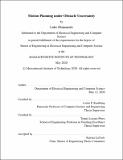| dc.contributor.advisor | Leslie P. Kaelbling and Tomás Lozano-Pérez. | en_US |
| dc.contributor.author | Shimanuki, Luke. | en_US |
| dc.contributor.other | Massachusetts Institute of Technology. Department of Electrical Engineering and Computer Science. | en_US |
| dc.date.accessioned | 2020-09-15T22:02:03Z | |
| dc.date.available | 2020-09-15T22:02:03Z | |
| dc.date.copyright | 2020 | en_US |
| dc.date.issued | 2020 | en_US |
| dc.identifier.uri | https://hdl.handle.net/1721.1/127523 | |
| dc.description | Thesis: M. Eng., Massachusetts Institute of Technology, Department of Electrical Engineering and Computer Science, May, 2020 | en_US |
| dc.description | Cataloged from the official PDF of thesis. | en_US |
| dc.description | Includes bibliographical references (pages 75-78). | en_US |
| dc.description.abstract | We consider the problem of motion planning in the presence of uncertain or estimated obstacles. A number of practical algorithms exist for motion planning in the presence of known obstacles by constructing a graph in configuration space, then efficiently searching the graph to find a collision-free path. We show that such a class of algorithms is unlikely to be practical in the domain with uncertain obstacles. In particular, we show that safe 2D motion planning among polytopes with Gaussian-distributed faces (PGDF) obstacles is NP-hard with respect to the number of obstacles, and remains 5A5C-hard after being restricted to a graph. Our reduction is based on a path encoding of MAXQHORNSAT and uses the risk of collision with an obstacle to encode variable assignments and literal satisfactions. This implies that, unlike in the known case, planning under uncertainty is hard, even when given a graph containing the solution. We further show by reduction from 3-SAT that both safe 3D motion planning among PGDF obstacles and the related minimum constraint removal problem remain NP-hard even when restricted to cases where each obstacle overlaps with at most a constant number of other obstacles. We then identify a parameter that determines the hardness of this problem. When this parameter is small, we present a polynomial time algorithm to find the minimum risk trajectory. When this parameter is larger, we are still able to guarantee an efficient runtime in exchange for an approximately optimal solution. This parameter seems to be small for most real world problems, suggesting that the tradeoff between computational efficiency and strong guarantees is not necessary. We also explore a connection between our work and previous work on the minimum constraint removal problem (MCR). | en_US |
| dc.description.statementofresponsibility | by Luke Shimanuki. | en_US |
| dc.format.extent | 78 pages | en_US |
| dc.language.iso | eng | en_US |
| dc.publisher | Massachusetts Institute of Technology | en_US |
| dc.rights | MIT theses may be protected by copyright. Please reuse MIT thesis content according to the MIT Libraries Permissions Policy, which is available through the URL provided. | en_US |
| dc.rights.uri | http://dspace.mit.edu/handle/1721.1/7582 | en_US |
| dc.subject | Electrical Engineering and Computer Science. | en_US |
| dc.title | Motion planning under obstacle uncertainty | en_US |
| dc.type | Thesis | en_US |
| dc.description.degree | M. Eng. | en_US |
| dc.contributor.department | Massachusetts Institute of Technology. Department of Electrical Engineering and Computer Science | en_US |
| dc.identifier.oclc | 1193029679 | en_US |
| dc.description.collection | M.Eng. Massachusetts Institute of Technology, Department of Electrical Engineering and Computer Science | en_US |
| dspace.imported | 2020-09-15T22:02:02Z | en_US |
| mit.thesis.degree | Master | en_US |
| mit.thesis.department | EECS | en_US |
